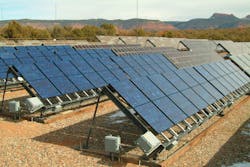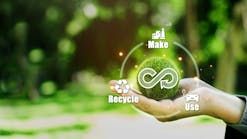Opportunities to implement renewable energy at water and wastewater utilities
At many water and wastewater utilities in the United States, energy use accounts for 30 percent or more of total costs. To account for this, some utilities are moving toward generating energy on-site and participating in programs to offset electrical grid usage. The use of renewables has nearly doubled, but still only represents 15 percent of today’s total energy generation.
Increasing energy demand for water systems, increasing energy prices, advancement toward greenhouse gas (GHG) emissions mitigation goals, and climate change are all driving moves to renewable energy. Distributed energy resources (DER) represent an exciting opportunity for drinking water and wastewater utilities. A project from The Water Research Foundation (WRF), Opportunities and Barriers for Renewable and Distributed Energy Resource Development at Drinking Water and Wastewater Utilities, is intended to provide guidance to drinking water and wastewater utilities that are planning or implementing renewables or DER in their operations.
The Federal Energy Regulatory Committee (FERC) defines DER as “small modular electricity or storage technologies, which are geographically dispersed” (FERC, 2017). Any project that is not part of the bulk energy system and has a capacity of 10 megawatts or fewer is considered a DER.
The main focus of this WRF project is how DER can be a successful energy management solution at water or wastewater utilities. Renewable energy refers to wind, solar, and biomass energy or sources that are constantly replenished. By self-generating power, utilities can reduce costs, improve reliability and resilience, and achieve the environmental co-benefit of GHG emission reduction. For example, wastewater treatment plants (WWTP) can capture carbon or utilize thermal energy. If this energy is captured, there is the opportunity to meet, and eventually exceed, energy requirements for WWTPs. Adding additional methods like organic waste digestion or incorporating wind or solar energy can result in the production of enough energy to be sold. Water and wastewater utilities are good candidates for DER because they may own large areas of land, have high energy demand, and have the ability to provide other types of ancillary grid services.
The research team conducted interviews with stakeholders and issued a survey to identify stakeholder interests on multiple components of DER, specifically opportunities and risks. A total of 249 survey responses were received using a global sampling pool. The participants ranked the current drivers for DER projects by level of importance. The top three drivers were the desire to acquire the energy source with the lowest cost to the utility, the need to reduce costs in terms of $/unit of water and wastewater produced or treated, and the need to address ongoing operational cost savings.
Across all responses, costs were the most important factor, while environmental drivers were not primary influences for investment in DER projects. The types of DER viewed as the most important at present are anaerobic digestion, solar-PV, and hydropower. In future scenarios, more prevalent strategies may include anaerobic digestion with co-digestion, solar-PV, and anaerobic digestion.
Additionally, the location of utilities greatly influenced the ranking of perceived DER priorities. For example, in the northern regions, anaerobic digestion was identified as the current most important DER type, while southern locations ranked solar-PV as the most important.
Several case studies were conducted to identify how utilities have overcome and leveraged regulatory frameworks related to DER development (see Table 1). The case studies explored project drivers, energy production capacity, and major stakeholders and decision-makers involved in DER projects to help other facilities determine renewable options.
For example, Metro Vancouver serves more than 2.4 million people and operates 5 WWTPs covering 24 municipalities. They do not explicitly produce energy but have energy available from the byproducts of the resources they manage, including water and both liquid and solid wastes. Metro Vancouver produces biogas through anaerobic digestion to heat their plants’ buildings and digesters. The Lulu Island Wastewater Treatment Plant (LIWWTP) Green Biomethane projects stemmed from a broader assessment of potential energy sources of Metro Vancouver that could be recovered to ultimately help reduce their GHG emissions. The project goal was to maximize the beneficial use of excess digester gas that would otherwise be flared, as almost 50 percent of biogas goes unused.
The Metro Vancouver Board supported the direction of the project and proposed the plan to FortisBC, a private electric power and gas distribution company. Their support was crucial for the project business case and to gain approval from the BC Utilities Commission, which regulates energy utilities. An estimated 30,000 GJ of renewable natural gas will be exported to the grid and is expected to increase over time as the plant treats larger volumes of liquid waste. A key success factor for this project was having project champions from Metro Vancouver and FortisBC, as well as the ability to demonstrate cost recovery and economic feasibility throughout the life of the project.
The New York City Department of Environmental Protection (NYCDEP) initiated two projects dealing with source-separated organic wastes for co-digestion, and a related project with National Grid (NGrid) to clean and export excess biogas from the facility into NGrid’s natural gas pipeline. NYCDEP reuses biogas from anaerobic digestion in 13 of 14 treatment plants, mostly for on-site boilers for heating or to power equipment.
The Newton Creek WWTP is the largest plant in the city and is the site for two DER projects. Working with Waste Management New York, NYCDEP performed a one-year, no-cost demonstration project focused on food collection logistics to ensure sufficient composition of food waste was created for processing and injection into the WWTP digesters. During the pilot-scale demonstration, Newton Creek WWTP co-digested 2 tons of food waste per day, and used the source-separated organics to generate bioslurry to produce biogas. This project is considered the first of its kind among NYCDEP WWTP facilities.
The second project was a public-private partnership with NGrid focused on utilizing a largely untapped renewable energy source and promoting renewable natural gas (RNG) development. It consists of a 20-year installation to utilize the existing waste stream, condition the biogas, and produce pipeline quality RNG to determine the most efficient method for gas flow. The project will inject enough RNG into the distribution network to heat approximately 2,500 homes and reduce carbon dioxide emissions by 16,000 tons/year.
The strongest project driver here was New York City’s commitment to sustainability and reducing GHG emissions. Both projects were supported by a strong alignment with the priorities and objectives set by their mayor’s sustainability goals. The mutual commitment to environmental and sustainability goals created a collaborative public-private partnership with each member aligned to the needs of addressing climate change. Planning holistically across wastewater, energy, and waste management sectors translated to greater environmental benefits for the city, breaking through the traditional siloes between those sectors.
Table 1. Summary of research case studies, showing types of renewable energy tested or utilized at full scale.These case studies provide examples of what utilities have done to implement DER projects and what the key success factors were. Addressing barriers to implementing DER requires policy actions that tackle the economic, technical, and risk factors faced by water and wastewater utilities.
To track changes in the DER market, water and wastewater utilities should consider how a typical electricity market regulator would classify them. For many DER projects, the fixed costs for recordkeeping, reporting, reliability, and other technical and regulatory requirements are likely too expensive to justify the projects. A strong motivation for a project and project development framework help identify the benefits and risks when implementing a DER initiative. When establishing a DER development process, project motivation and project development frameworks are crucial considerations to develop a baseline of benefits and risks in order to provide a basic design for implementation of DER projects.
Communication with local stakeholders can establish reasonable expectations when it comes to development. Educating local constituents of the benefits of DERs can increase public acceptance of the project. Renewable energy holds a lot of promise for reducing costs and meeting energy goals. With these drivers and support behind a project, DER can provide significant benefits to any utility. WW




